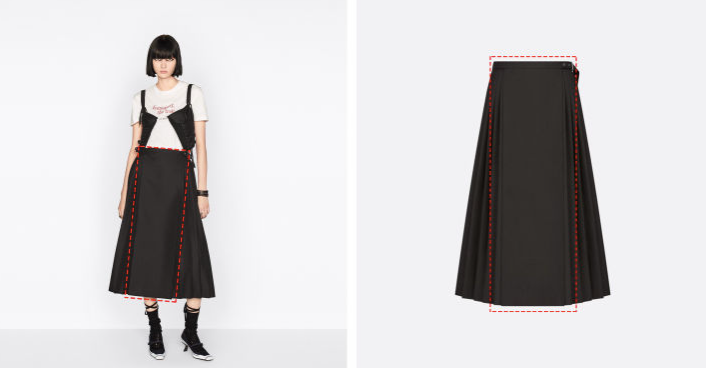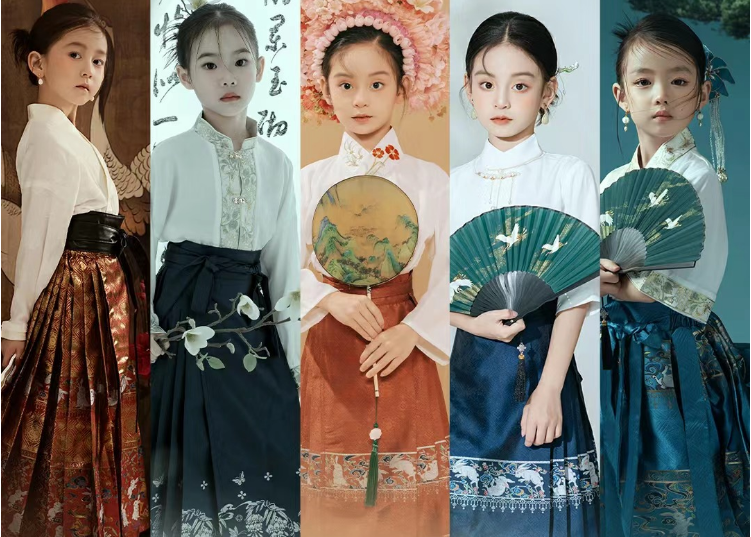Horse Face Skirt: Everything You Need To Know About It
- knowledge
Dior recently unveiled a skirt that has sparked widespread controversy for allegedly being highly similar to the traditional Chinese horse-faced dress.
According to online discussions and media reports, the features of the dress include the design concept of overlapping the front and back cut, which is in line with the characteristics of the horse skirt.
Dior’s official website describes the dress as “a new elegant and stylish piece with the iconic Dior silhouette”, making no mention of the horse-faced dress or Chinese cultural elements.

So what is a horse skirt and Why is it so popular?
This article and guide will take guide you deep into the world of making the horse-face skirt, exploring its historical origins, structural design, and diverse styles, together delving into the charm of making this classical attire.
What is Hores Face Skirt?

Horse face skirt, also known as “horse face”, is a traditional skirt style from China, its name comes from the skirt before and after a show showing a large area of decorative pattern similar to the shape of a horse face, so the name. Usually made of soft materials such as silk, the dress is known for its smooth lines, fine patterns and elegant appearance.
The History Of Hores Face Skirt
The origins of the horse-face skirt can be traced back to the Song Dynasty, when the winding skirt was a two-piece skirt, designed to facilitate travel on donkeys. The structural characteristics of this hanfu skirt have begun to take shape.
In the Ming Dynasty, the horse-face skirt gradually formed and became popular. Its typical characteristics were the flat and smooth area formed by the coincidence of the central skirt door, and the symmetrical distribution of pleats on both sides, which resembled the “horse-face” building in the city wall.
In recent years, in the tide of the Hanfu movement and the revival of traditional culture, the horse skirt has received new attention and inheritance. Modern designers have improved and re-created the horse skirt on the simple basis of respecting the tradition, making it so that it not only retains the traditional charm, but also adds modern aesthetic elements and wearing habits.
The Parts Of Hores Face Skirt
Skirt Gates:
The mamianqun has four skirt gates, two in the front and two in the back, which overlap to form the two main visual areas shown, namely the “horse-face”.
Pleats:
Pleats are added to the sides of the skirt to create a three-dimensional and layered effect. The pleats are large and sparse, usually attached to a differently colored skirt waist.
Skirt Waist:
The skirt waist is a ribbon often made of white fabric, symbolizing the traditional Chinese concept of “white-haired together” in marriage. It is adorned with ties at both ends to secure the skirt around the waist.
Decorations:
The outer skirt gates are usually adorned with rich decorations such items jewelry such as embroidery, woven gold, or printed patterns symbolizing auspicious meanings, while the inner skirt gates have fewer or no decorations.
Skirt Hem:
The wide border at the bottom of the skirt and around the knees is an important decorative part of making the horse-face skirt, often embellished with auspicious patterns.
The Parts Of Hores Face Skirt
Symmetry:
The design of the mamainqun emphasizes symmetry, with the even distribution of the front and back skirt gates and the uniform arrangement of pleats on both sides, reflecting the aesthetic characteristics of ancient Chinese clothing.
Decorativeness:
The mamianqun skirt is highly decorative, with elaborate patterns on the outer skirt gates. Common motifs include bats, clouds, lanterns, the Eight Treasures, as well as high-level symbols like dragons, phoenixes, and mythical creatures.
Color and Material:
The horse-face skirt pursues perfect harmony in color coordination and uses soft and high-quality materials such as silk, ensuring both visual and tactile aesthetics.
Integration of Functionality and Aesthetics:
The design of the horse-face skirt not only focuses on aesthetics but also considers comfort and functionality. The white fabric and adjustable ties at the waist ensure a snug and comfortable fit.
Cultural Symbolism:
The design and decoration of the shoes and the horse-face skirt are rich in symbolic meanings of traditional Chinese culture, such as the symbolism of longevity and auspicious patterns, showcasing the profound cultural connotations of Chinese tradition.
The Style of Horse Face Skirt
As a classic style of traditional Chinese clothing, the style and design of horse-face skirt have evolved with time, the development of history and the change of modern aesthetics, forming a variety of styles.
Traditional style
Traditional horse-face dresses are often decorated with various auspicious patterns, such as bats, moire, lanterns, eight treasures, etc., as well as high-level symbols such as dragons and phoenixes, cloud pythons, etc., reflecting the connotation and aesthetics of traditional Chinese culture.
In terms of color, the traditional horse skirt pursues harmony and luck, common bright colors such as bright red, sapphire blue, emerald green, and more elegant black, white and gray and other simple colors.
The shape of the traditional horse-face skirt began in the Ming Dynasty and continued to the Republic of China, with the design of four skirt doors inside and outside, overlapping in pairs to form a unique “horse-face” area.
Modern Style
Modern designers have improved the MaMianQun skirt on the simple basis of respecting the tradition, combining modern aesthetics and wearing habits, making simple move, such as narrowing the skirt waist, changing the pleat design, etc., to make making it more suitable for women in modern life.
Modern horse-face skirts are also innovative in fabric. In addition to traditional silk, cotton, linen, lace and other materials may be used to increase the comfort and breathability of the clothing.
The pattern design of modern horse skirt is more diversified, not only has traditional auspicious patterns, but also may choose to incorporate modern elements, such as abstract patterns, pop culture symbols, etc., to meet the personalized needs of different consumers.
Is it okay for foreigners to wear Horse Face Skirt?
Yes, it is generally acceptable for foreigners to wear a Horse Face Skirt, also known as “Ma Mian Qun” (马面裙) in Chinese. Traditional Chinese clothing, including the Horse Face Skirt, has gained international recognition and appreciation as cultural symbols.
Many people from different cultural backgrounds wear traditional attire from various countries as a form of cultural appreciation, fashion, or for special occasions. As long as it is worn respectfully and with appreciation for its cultural significance, there is typically no issue with foreigners wearing the Horse Face Skirt or other traditional Chinese garments.
Where to Buy Horse Face Skirt?
From you read the above post and discussion, you may have a basic understanding of horse skirt and traditional Chinese culture. If you want to learn more information on how to have an idea of buying a horse skirt, you can click here to visit Delleb – a brand that focuses on traditional Hanfu.
If you can’t find the style you like on Delleb’s official website, you can also search and buy it through other platforms such as Amazon and eBay. No matter where you are, you can easily experience the charm of traditional Chinese clothing.

